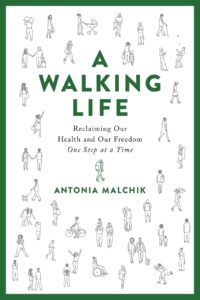There’s a reason you feel better after a good walk. Antonia Malchik shares the key ways walking can enhance and develop your creativity
As a writer in a master’s program in my mid-twenties, I constantly received the same advice given to all young or new writers: keep your butt in your chair.
Standing up and walking away from the desk was seen as failure.
It took spending two years writing a book about walking for me to see that the opposite is true.
Steve Jobs famously insisted on walking meetings
Sitting in the chair when I don’t want to be there results in poor quality writing and a fidgety, anxious brain and body, I learned.
I still have to get those words on the page and spend many hours editing and revising, but if I make walking an intentional part of the process it’s not only more interesting and productive, it’s a lot more fun.
And, it turns out, there is plenty of scientific research showing why that’s true.
#1 It helps develop your problem solving skills
A 2014 study at Stanford University found that going for a walk significantly increased students’ abilities to engage in creative thinking and problem solving.
The study applied science to something that’s been known anecdotally for centuries. Some of the best-known creative people in the world have made walking an essential part of their creative practice.
Tchaikovsky walked for forty-five minutes every morning, and took another two-hour walk in the middle of the day after composing.
Steve Jobs famously insisted on walking meetings.
The philosopher Jean-Jacques Rousseau claimed that he could only think while walking. ‘My mind only works with my legs,’ he wrote, centuries before Stanford researchers could back him up.
 #2 Reduces stress-levels
#2 Reduces stress-levels
A number of studies have shown that walking reduces stress levels.
Part of the effect is due to the motion itself, but part is also due to the different sensory stimuli gained from moving around outside.
A 2015 study in Edinburgh used EEG to track walkers in three different environments, and found that walking in green spaces resulted in lower frustration and higher meditation.
When I’m anxious, or have a number of stressful thoughts or experiences I’m coping with, I tend to walk quickly, and find that my thinking keeps pace.
Invariably, I find that slowing myself down physically is reflected in my thinking: thoughts stop feeling like an overheating steam train; some of them drift away because they were unimportant to begin with, and others start to unwind and gain appropriate perspective.
Walking brings my cortisol levels and blood pressure down, leaving room for creative ideas to bubble up.
And not just for my writing—life is full of problems that demand creative solutions, from parenting to politics.
These situations bring their own stress, but in walking they also find their own answers.
#3 It helps you focus
It’s no secret by now that our tech-saturated world demands a lot of our attention.
It’s hard to get good work done on a deep creative project when you’re constantly being interrupted by emails, text messages, or the urge to check social media constantly.
One well-known study showed that people working in an office switch tasks through interruption every three minutes. The problem is that it takes around twenty minutes to fully regain focus on the original task.
That study was done in 2008; once social media came on the scene the time between interruptions shortened even further.
There’s a lot of concern, and some emerging science, that the relentless demands on attention are changing the way our brains function, making it hard for us to focus on one thing for any length of time.
When I’m caught in a streak of harried, busy days, whether from work or parenting or too many times checking Instagram, going for a long walk—preferably without my smartphone—is like getting a deep tissue massage for my mind.
If I can get a couple of hours of walking in, my mind and body both feel refreshed and refocused. Even twenty minutes helps trigger a reset button.
Stepping away from the demands on my attention clears a lot of clutter out of my thoughts and helps my mind stay focused instead of jumping around all over the place.
#4 It helps you experience your mind and body as a whole
An increasing amount of research coming from areas like neuroscience and early childhood development is focused on the concept of embodiment.
For centuries, our thinking 
Embodiment brings the two back together, recognizing that our experience of the world as living, breathing, walking mammals is what shapes our minds.
A 2016 study published in Frontiers in Psychology found that our built environments shape a great deal of our sense of self.
How we relate to spaces, and the kinds of spaces we live in and around, defines our social cognition as well as our spatial cognition.
Our minds, in other words, are not separate from our experience of the actual, real-life world. And our creative selves are fed by that experience.
The early writing advice I received to “keep your butt in your chair” almost never resulted in better work; it resulted in me being tired, cranky, and out of ideas.
Once I started making walking part of my writing practice, the human experience of being in the world came to define that work, in part because I was rediscovering what the human experience meant for myself.
We spend a tremendous amount of our lives severed from the world around us, in homes or offices or cars or, increasingly, online, and this experience can make creative thinking small and internal—not always, but often.
Creative thinking of all kinds asks that we be fully alive and aware of the world, and that we fully experience it.
#5 It really does make you more creative

The thrill of a creative spark comes when you see something you hadn’t noticed before, or see it in a different way, or make connections that only seem obvious once you put them together.
Going for a walk brings in a host of stimuli that inform your mind and enrich your thoughts. We need it to build our imaginations.
There is now a mountain of research showing that children in particular need a lot of three-dimensional movement as they’re growing, walking places in particular, to fully develop the hippocampus region of their brains.
The hippocampus is where we get a sense of spatial relations and is also where we build long-term memory.
A lot goes on in the hippocampus when we’re walking, like figuring out how far away things are or how fast they’re moving, and responding to a sense of “up” and “down.”
In children, this manifests when they’re learning to read and do arithmetic, both of which require humans to figure out how particular abstract ideas relate to one another in concrete ways.
The hippocampus is also used in mental scanning (for example, if I asked you to picture the dairy section of your supermarket, you’d use mental scanning to bring that place to mind)—or what we commonly call imagination.
#6 It boosts your mood
Extensive research shows that walking decreases rumination, the type of negative thinking associated with depression.
And while creativity has long been associated with mood disorders like depression, only recently have studies found evidence for the link.
In 2018 researchers at Albany State University studied 3000 people and found that “creative types” were indeed more prone to major depression.
This doesn’t mean, though, that you have to live with depression in order to be creative. I’ve experienced bouts of deep depression over the years, and nothing matches it for killing not only my creativity but also any desire to start writing again.
Over and over, I’ve found that walking even short distances is the best way to keep depression from gelling in my psyche and my body, and letting me pick up the pen again. Science, once again, backs up this experience. A large Australian study of nearly 2000 women found that 200 minutes of walking per week significantly alleviated depression, and there have been other studies throughout Europe with similar results.
 #7 It helps you prioritise your thoughts
#7 It helps you prioritise your thoughts
One of the hardest things about working creatively, no matter the field, is figuring out where to start or what to work on.
When it does come to the butt-in-chair time, setting an intention for what to work on can make the difference between a productive creative day and one that feels wasted.
Meditation can be a wonderful way to transition from non-work time into working, but I personally find that walking meditation helps me clarify what I want to work on, and how, far more quickly and precisely than sitting meditation does.
When I’m in the midst of a huge project like writing a book, and am unsure what to work on that day, I pull on some shoes, step outside, and let the walking do the deciding for me.
Antonia Malchik is a freelance writer living in Whitefish, Montana, and is the author of A Walking Life: Reclaiming Our Health and Our Freedom One Step at a Time available to purchase on Amazon.
Relevant Healthista Content
8 ways walking can help depression and anxiety – the psychotherapist’s guide
8 ways walking in the woods can make you happier
3 breathing techniques this Instagram super yogi swears by
5 fat loss supplements proven by science
4 ways stress is showing on your skin and exactly how to cope
These immune boosting superfoods will be on everyone’s lips in 2020
Like this article? Sign up to our newsletter to get more articles like this delivered straight to your inbox.




 #2 Reduces stress-levels
#2 Reduces stress-levels
 #7 It helps you prioritise your thoughts
#7 It helps you prioritise your thoughts

















































